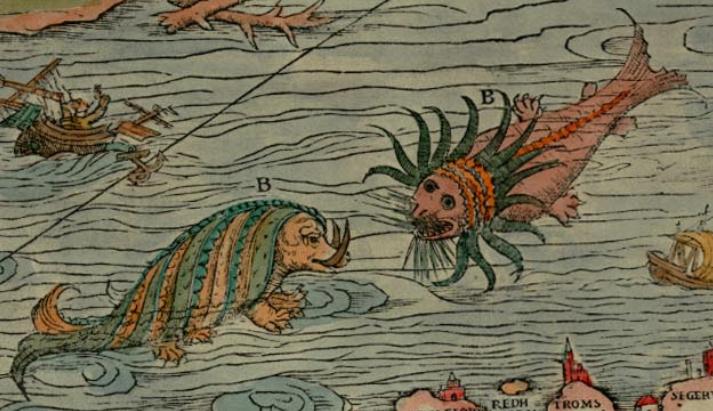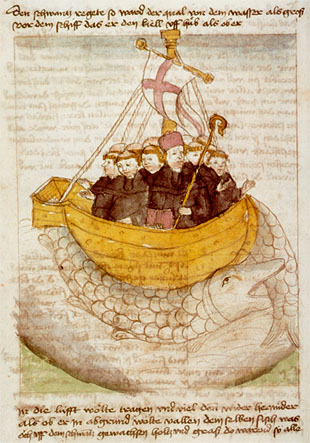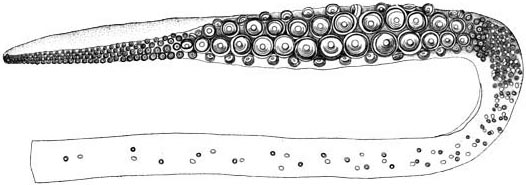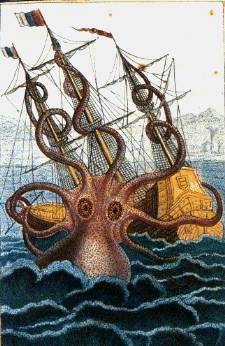|
Kraken
The kraken () is a legendary sea monster of enormous size said to appear off the coasts of Norway. Kraken, the subject of sailors' superstitions and mythos, was first described in the modern age at the turn of the 18th century, in a travelogue by Francesco Negri in 1700. This description was followed in 1734 by an account from Dano-Norwegian missionary and explorer Hans Egede, who described the kraken in detail and equated it with the ''hafgufa'' of medieval lore. However, the first description of the creature is usually credited to the Norwegian bishop, Pontoppidan (1753). Pontoppidan was the first to describe the kraken as an octopus (polypus) of tremendous size, and wrote that it had a reputation for pulling down ships. The French malacologist, Denys-Montfort, of the 19th century is also known for his pioneering inquiries into the existence of gigantic octopuses. The great man-killing octopus entered French fiction when novelist Victor Hugo (1866) introduced the ' octop ... [...More Info...] [...Related Items...] OR: [Wikipedia] [Google] [Baidu] |
Hafgufa
( non, haf "sea" + non, gufa "steam"; "sea-reek"; "sea-steamer") is a legendary massive sea monster (or whale), purported to inhabit Iceland's waters (Greenland Sea) and southward towards Helluland. When the creature remains stationary it is mistaken for an island. The hafgufa is mentioned in the mid-13th century Norwegian tract called the ''Konungs skuggsjá'' ("King's Mirror"). Later recensions of ''Örvar-Oddr, Örvar-Odds'' saga feature ''hafgufa'' and ''lyngbakr'' as similar but distinct creatures. According to the Norwegian didactic work, this creature uses its own vomit like chumming bait to gather prey fish. In the ''Fornaldarsaga'', the hafgufa is reputed to consume even whales or ships and men, though Oddr's ship merely sailed through its jaws above water, which appeared to be nothing more than rocks. Nomenclature This creature's name appears as in Old Norse in the 13th century Norwegian work. In the ''Snorra Edda'', the ''hafgufa'' ("sea-steamer") appears in the ... [...More Info...] [...Related Items...] OR: [Wikipedia] [Google] [Baidu] |
Giant Squid
The giant squid (''Architeuthis dux'') is a species of deep-ocean dwelling squid in the family Architeuthidae. It can grow to a tremendous size, offering an example of abyssal gigantism: recent estimates put the maximum size at around Tracey, D. M., O. F. Anderson & J. R. Naylor (2011)''A guide to common deepsea invertebrates in New Zealand waters. Third edition.''National Institute of Water and Atmospheric Research, Wellington. 317 pp.Yukhov, V. L. (2014)Гигантские кальмары рода ''Architeuthis'' в Южном океане / Giant calmaries ''Аrchiteuthis'' in the Southern ocean igantskiye kalmary roda ''Architeuthis'' v Yuzhnom okeane.''Ukrainian Antarctic Journal'' no. 13: 242–253. for females and for males, from the posterior fins to the tip of the two long tentacles (longer than the colossal squid at an estimated , but substantially lighter, due to the tentacles making up most of the length). The mantle of the giant squid is about long ... [...More Info...] [...Related Items...] OR: [Wikipedia] [Google] [Baidu] |
Pierre Denys De Montfort
Pierre Denys de Montfort, also sometimes spelled "Pierre Dénys de Montfort", (1766–1820) was a French naturalist, in particular a malacologist, remembered today for his pioneering inquiries into the existence of the gigantic octopuses. He was inspired by a description from 1783 of an eight-metre long tentacle found in the mouth of a sperm whale. Montfort was author of ''Conchyliologie systématique, et classification méthodique de coquilles'' (2 vols., Paris 1808–1810) and of ''Histoire Naturelle Générale et Particulière des Mollusques'' (2 vols., Paris 1801–1802) published as an addendum to the comte de Buffon's '' Histoire Naturelle, générale et particulière''. He appears also to have been the author of ''Petit vocabulaire à l'usage des Français et des Alliés, renfermant les noms d'une partie des choses les plus essentielles à la vie en plusieurs langues: français, Latin, hébreu, hollandais, allemand, anglais, espagnol, italien, etc par M. Denys de Montf ... [...More Info...] [...Related Items...] OR: [Wikipedia] [Google] [Baidu] |
Christian Franz Paullini
Christian Franz Paullini (25 February 1643 – 10 June 1712) was a German physician and theologian. Biography Paullini was born in Eisenach to a family of merchants and scholars. His parents wanted him to become a priest and his initial education was designed with this in mind, but Paullini was attracted to the medicinal arts and studied both theology and medicine. He attended middle school and secondary school in Thuringia and graduated from Coburg. Paullini studied theology and medicine in Gdańsk, Königsberg, Rostock, Lübeck, Kiel and Copenhagen, was Magister Artium in Wittenberg and received his MD in Leiden. Meanwhile, he accomplished study stays and courses in Cambridge, Oxford, Sweden, Norway and Iceland.Pauliini was the personal physician of the Prince-Bishop of Munster Christoph Bernhard von Galen and later of the Duke of Brunswick in Wolfenbüttel. Paullini returned to Eisenach in 1685 and 1689 where he assumed the position of "Ducal Stadtphysicus" i.e. city docto ... [...More Info...] [...Related Items...] OR: [Wikipedia] [Google] [Baidu] |
Erik Pontoppidan
Erik Ludvigsen Pontoppidan (24 August 1698 – 20 December 1764) was a Danish author, a Lutheran bishop of the Church of Norway, an historian, and an antiquarian. His Catechism of the Church of Denmark heavily influenced Danish and Norwegian religious thought and practice for roughly the next 200 years after its 1737 publication. Biography Pontoppidan was educated in Fredericia (1716–1718), after which he was a private tutor in Norway, and then studied in Holland, and in London and Oxford, England. In 1721 he became ''informator'' of Frederick Carl of Carlstein (later duke of Plön), and two years later morning preacher in the castle and afternoon preacher in Nordborg. From 1726 to 1734 he was pastor at Hagenberg, where he so protected the pietists as to find it advisable to defend his course against the Lutherans with ''Dialogus; oder Unterredung Severi, Sinceri, und Simplicis von der Religion and Reinheit der Lehre'' (1726) and ''Heller Glaubensspiegel'' (1727). During this ... [...More Info...] [...Related Items...] OR: [Wikipedia] [Google] [Baidu] |
Carl Linnaeus
Carl Linnaeus (; 23 May 1707 – 10 January 1778), also known after his ennoblement in 1761 as Carl von Linné Blunt (2004), p. 171. (), was a Swedish botanist, zoologist, taxonomist, and physician who formalised binomial nomenclature, the modern system of naming organisms. He is known as the "father of modern taxonomy". Many of his writings were in Latin; his name is rendered in Latin as and, after his 1761 ennoblement, as . Linnaeus was born in Råshult, the countryside of Småland, in southern Sweden. He received most of his higher education at Uppsala University and began giving lectures in botany there in 1730. He lived abroad between 1735 and 1738, where he studied and also published the first edition of his ' in the Netherlands. He then returned to Sweden where he became professor of medicine and botany at Uppsala. In the 1740s, he was sent on several journeys through Sweden to find and classify plants and animals. In the 1750s and 1760s, he continued to collect an ... [...More Info...] [...Related Items...] OR: [Wikipedia] [Google] [Baidu] |
Thomas Bartholin
Thomas Bartholin (; Onomastic Latinizatio, Latinized as ''Thomas Bartholinus''; 20 October 1616 – 4 December 1680) was a Denmark, Danish physician, mathematician, and theology, theologian. He is best known for his work in the discovery of the lymphatic system in humans and for his advancements of the theory of refrigeration anesthesia, being the first to describe it scientifically. Thomas Bartholin came from a family that has become famous for its pioneering scientists, twelve of whom became professors at the University of Copenhagen. Three generations of the Bartholin family made significant contributions to anatomical science and medicine in the 17th and 18th centuries: Thomas Bartholin's father, Caspar Bartholin the Elder (1585–1629), his brother Rasmus Bartholin (1625–1698), and his son Caspar Bartholin the Younger (1655–1738).Hill, Robert V. (2007"A Glimpse of Our Past – The contributions of the Bartholin family to the study and practice of clinical anatomy ... [...More Info...] [...Related Items...] OR: [Wikipedia] [Google] [Baidu] |
Samuel Latham Mitchill
Samuel Latham Mitchill (August 20, 1764September 7, 1831) was an American physician, naturalist, and politician who lived in Plandome, New York. Early life Samuel Mitchill was born in Hempstead in the Province of New York, the son of Robert Mitchill and his wife, Mary Latham, both Quakers. He was sent to Scotland and graduated in 1786 from the University of Edinburgh Medical School with an M.D., his education being paid for by a wealthy uncle. Returning to the United States after medical school, Mitchill also completed law school. As a lawyer, he oversaw the purchase of lands in western New York from the Iroquois Indians in 1788. Career Mitchill taught chemistry, botany, and natural history at Columbia College from 1792 to 1801 and was a founding editor of ''The Medical Repository'', the first medical journal in the United States. In 1793, he was elected a Foreign Fellow of the Royal Society of Edinburgh. His proposers were James Gregory, Dugald Stewart, and John Rotherham. ... [...More Info...] [...Related Items...] OR: [Wikipedia] [Google] [Baidu] |
Cephalopod
A cephalopod is any member of the molluscan class Cephalopoda (Greek plural , ; "head-feet") such as a squid, octopus, cuttlefish, or nautilus. These exclusively marine animals are characterized by bilateral body symmetry, a prominent head, and a set of arms or tentacles (muscular hydrostats) modified from the primitive molluscan foot. Fishers sometimes call cephalopods "inkfish", referring to their common ability to squirt ink. The study of cephalopods is a branch of malacology known as teuthology. Cephalopods became dominant during the Ordovician period, represented by primitive nautiloids. The class now contains two, only distantly related, extant subclasses: Coleoidea, which includes octopuses, squid, and cuttlefish; and Nautiloidea, represented by ''Nautilus'' and ''Allonautilus''. In the Coleoidea, the molluscan shell has been internalized or is absent, whereas in the Nautiloidea, the external shell remains. About 800 living species of cephalopods have been ident ... [...More Info...] [...Related Items...] OR: [Wikipedia] [Google] [Baidu] |
Systema Naturae
' (originally in Latin written ' with the ligature æ) is one of the major works of the Swedish botanist, zoologist and physician Carl Linnaeus (1707–1778) and introduced the Linnaean taxonomy. Although the system, now known as binomial nomenclature, was partially developed by the Bauhin brothers, Gaspard and Johann, Linnaeus was first to use it consistently throughout his book. The first edition was published in 1735. The full title of the 10th edition (1758), which was the most important one, was ' or translated: "System of nature through the three kingdoms of nature, according to classes, orders, genera and species, with characters, differences, synonyms, places". The tenth edition of this book (1758) is considered the starting point of zoological nomenclature. In 1766–1768 Linnaeus published the much enhanced 12th edition, the last under his authorship. Another again enhanced work in the same style and titled "'" was published by Johann Friedrich Gmelin between 1788 a ... [...More Info...] [...Related Items...] OR: [Wikipedia] [Google] [Baidu] |
Old Norse
Old Norse, Old Nordic, or Old Scandinavian, is a stage of development of North Germanic languages, North Germanic dialects before their final divergence into separate Nordic languages. Old Norse was spoken by inhabitants of Scandinavia and their Viking expansion, overseas settlements and chronologically coincides with the Viking Age, the Christianization of Scandinavia and the consolidation of Scandinavian kingdoms from about the 7th to the 15th centuries. The Proto-Norse language developed into Old Norse by the 8th century, and Old Norse began to develop into the modern North Germanic languages in the mid-to-late 14th century, ending the language phase known as Old Norse. These dates, however, are not absolute, since written Old Norse is found well into the 15th century. Old Norse was divided into three dialects: Old West Norse, ''Old West Norse'' or ''Old West Nordic'' (often referred to as ''Old Norse''), Old East Norse, ''Old East Norse'' or ''Old East Nordic'', and ''Ol ... [...More Info...] [...Related Items...] OR: [Wikipedia] [Google] [Baidu] |
Finnur Jónsson
Finnur Jónsson (May 29, 1858 – March 30, 1934) was an Icelandic-Danish philologist and Professor of Nordic Philology at the University of Copenhagen. He made extensive contributions to the study of Old Norse literature. Finnur Jónsson was born at Akureyri in northern Iceland. He graduated from Menntaskólinn í Reykjavík in 1878 and went to Denmark for further studies at the University of Copenhagen. He received a doctorate in philology in 1884 with a dissertation on skaldic poetry. He became a docent at the university in 1887 and a professor in 1898, serving until 1928. After retiring he continued work on his subject with new publications until the year he died. He was elected member of the Royal Society of Arts and Sciences in Gothenburg in 1905 and corresponding member of the Royal Swedish Academy of Letters, History and Antiquities in 1908. Finnur's principal area of study was Old Norse poetry. His three most important works are ''Den norsk-islandske skjaldedigtning' ... [...More Info...] [...Related Items...] OR: [Wikipedia] [Google] [Baidu] |






.jpg)
.png)
